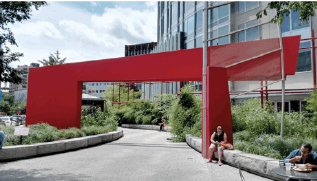What is Landscape Architecture?
Introduction
The definition of landscape architecture by the American Society of Landscape Architects (ASLA) is “the science and art of design, planning, management and stewardship of the land. Landscape architecture involves natural and built elements, cultural and scientific knowledge, and concern for resource conservation to the end that the resulting environment serves a useful and enjoyable purpose. Successful landscape architecture maximizes use of the land, adds value to a project and minimizes costs, all with minimum disruption to nature”.1
The term landscape architecture was first used in an 1828 book titled On the Landscape Architecture of the Great Painters of Italy by a Scottish gentleman, Gilbert Laing Meason (1769-1832). Frederick Law Olmsted was the first person in the U.S. to use landscape architect as a formal professional title when he designed Central Park in New York City in 1858. Therefore, Frederick Law Olmsted is commonly considered the Father of American Landscape Architecture by the modern profession.
Since the profession of landscape architecture evolved from landscape gardening, it is not uncommon for the public to confuse landscape architecture with other landscape/ landscaping related professions. As the profession of landscape architecture evolved, it was shaped largely by the needs of modern society. Now, it covers not only small-scale private projects, but also involves planning and designing public spaces. Landscape architects take on the role of designer and manager of design projects while working in a complementary role to the landscape contractor, who is in charge of the project installation.
Importance of Landscape Architecture
Landscape Architecture is a rewarding and important green career in high demand especially as development continue to impact the natural environment. As the Landscape Institute in the UK defines it, landscape architecture is “a creative profession, skilled in strategic planning, delivery and management. It is rooted in an understanding of how the environment works and what makes each place unique.”2 Landscape architects are both “artists” and “doctors” to the outdoor spaces. They not only add beautifications to the land, but also solve complex environmental problems and create a quality environment for people’s health and well-being. In many projects, landscape architects actively collaborate with other disciplines, including architects, civil engineers and city planners.
Education of Landscape Architecture
Before beginning a career in landscape architecture, formal education with either a professional degree of Bachelor of Landscape Architecture or a Master of Landscape Architecture is required. Bachelor’s degrees usually require four to five years and Master’s degrees an additional three years of study and training in design, technical skills, art and natural sciences.
After graduation, states require the completion of registration exams to obtain the licensure to be legally titled a Landscape Architect. For example, in the State of Oklahoma, the Board of Architects, Landscape Architects, Interior Designers oversees the licensure of the profession. Prior to taking the exams, one is generally required to work two to three years full time, practicing in a design firm under a licensed landscape architect’s supervision.
What Types of Projects Do Landscape Architects Do?
There are many landmark places designed by landscape architects that people can recognize immediately, such as the Central Park in New York City mentioned above, Millennium Park in Chicago and Myriad Gardens in Oklahoma City in our own great state of Oklahoma.
A list of the types of projects landscape architects plan and design include the following.
- Parks and public open spaces (Figures 1, 2 and 3).

Figure 1. Guthrie Green, Tulsa, OK designed by SWA (Photo source: SWA)

Figure 2. Chinatown Park, Boston, MA designed by Carol R. Johnson Associates (CRJA-IBI) (Photo source: Qing Lana Luo)

Figure 3. Chinatown Park, Boston, MA designed by Carol R. Johnson Associates (CRJA-IBI) (Photo source: Qing Lana Luo)
- Urban squares and plazas (Figure 4)

Figure 4. Urban plaza at Boston Children’s Museum designed by Michael Van Valkenburgh Associates (Photo source: Qing Lana Luo)
- Streetscapes
- Gardens (Figure 5)

Figure 5. Lurie Garden in Millennium Park at fall, Chicago designed by Gustafson Guthrie Nichol Ltd & Terry Guen Design Associates, Inc. (Photo source: Michael Holmes)
- School campuses
- Private residences and estates
- Corporate office parks
- Institutions (Figure 6)

Figure 6. Art Institute of Chicago, South Garden designed by Dan Kiley. (Photo source: Michael Holmes)
- Whaterfronts (Figure 7)

Figure 7. Mediterranean Sea ocean front in Tel Aviv, Israel. (Photo source: Qing Lana Luo)
- Commercial and mixed use
- Children's outdoor environments (Figure 8)

Figure 8. Alexander W. Kemp Playground at Cambridge Common, Harvard Square, Massachusetts (Photo source: Qing Lana Luo)
- Arboreta (Figure 9)

Figure 9. Myriad Botanical Gardens, Oklahoma City, OK designed by OJB. (Photo source: OJB)
- Historic preservation
- Hotels & resorts
- Healthcare
- Senior living
- Urban design
- Transportation
- Cemeteries
- Athletics
- Land planning
- Community design
- Memorials
- Security design (Figure 10)

Figure 10. Reinforced retaining wall as part of the security design at the front of Federal Reserve Bank of Minneapolis. (Photo source: Qing Lana Luo)
- Therapeutic gardens
- Sustainable stormwater management
- Green infrastructure planning and design (Figures 11, 12 and 13)

Figure 11.

Figure 12.

Figure 13.
Figures 11, 12 and 13. The High Line, New York City, NY designed by James Corner Field Operations (photo source: Keith Jacob)
Landscape Architecture Professional Institutes
In the U.S. and many other countries, landscape architecture is a regulated profession. There are usually one or more professional institutes in these countries regulating the practices, protecting and promoting its interests.
In the U.S., the national association of the American Society of Landscape Architects (ASLA) represents the landscape architecture profession. By ASLA’s mission statement, it is “a professional society that represents landscape architects in the U.S. and Canada and seeks to better the practice and understanding of landscape architecture through education, research, state registration and other programs.” Branch chapters of ASLA are active at the regional and/or state levels.
In other countries, for example, in the United Kingdom, the professional association is the Landscape Institute functioning similarly as ASLA in the USA. The Australian Institute of Landscape Architects (AILA), the Canadian Society of Landscape Architects(CSLA) in Canada and the Chinese Society of Landscape Architecture (CHSLA) are all professional associations in their countries.
Online Resources to Learn More about Landscape Architecture
http://www.asla.org/design/index.html
http://landscapearchitecturemagazine.org/
http://www.bls.gov/ooh/architecture-and-engineering/landscape-architects.htm
References
- ASLA: Glossary. Retrieved from http://www.asla.org/nonmembers/publicrelations/glossary.htm
- Landscape Institute | What landscape architects offer. Retrieved from http://www.landscapeinstitute.org/registeredpractices/clientsguide_offer.php
Qing Lana Luo, MLA, PLA
Assistant Professor and
Landscape Architecture Extension Specialist
Michael V. Holmes, MLA
Associate Professor and
Landscape Architecture Program Director
